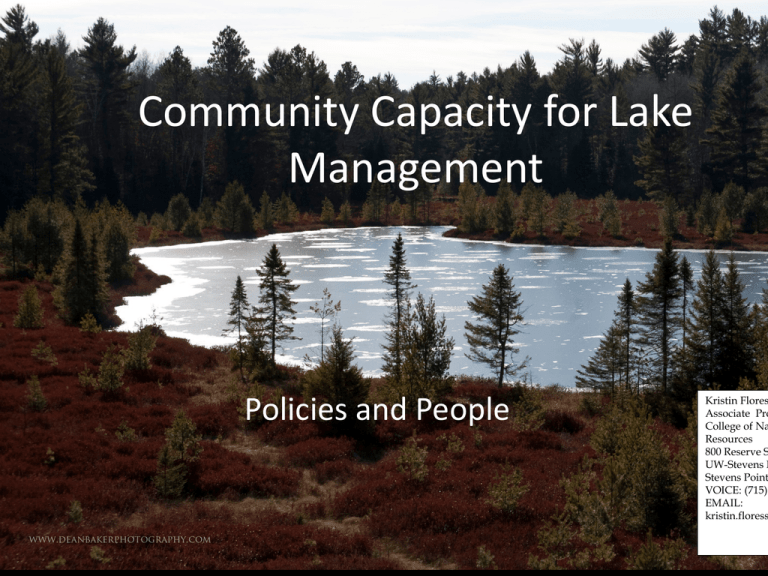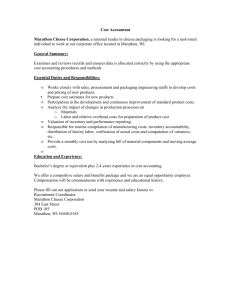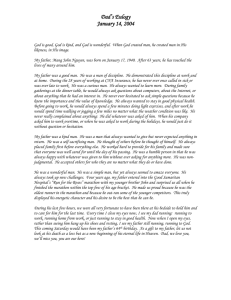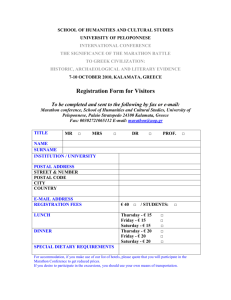Community Capacity for Lake Management Policies and People
advertisement

Community Capacity for Lake Management Policies and People Kristin Flores Associate Pro College of Na Resources 800 Reserve S UW-Stevens P Stevens Point VOICE: (715) EMAIL: kristin.floress Sustainable Watershed Management: Policy Networks Organizational Capacity Regulations Relational Capacity Education Individual Capacity Technical Assistance Programmatic Capacity Financial Incentives Trust, Legitimacy, and Fairness Adapted from Davenport & Seekamp (2013) 2 Sustainable Watershed Management Individual Capacity Programmatic Capacity Enhancing programs requires: • Coordination • Communication • Civic Engagement • Capacity Building • Program Evaluation Coordination and Communication Actors Institutions Watershed management programs Incentives Education Outreach Legislation Regulation Policy Management Plans Management Guidelines Institutional Agreements What do we need to know about programs impacting lakes? • People working in program delivery – What are their responsibilities? – How do they carry them out? – What policies impact their work? • Policies and plans – What policies and plans exist at the local, state, and federal level that impact lake management? – What and whom do the policies impact? Essentially, what is the system of governance with regard to the resource? What is governance? The political, social, economic, and administrative systems that are in place, and which directly or indirectly affect the use, development, and management of water resources Watergovernance.org Transparent Effective Good Governance Equitable Accountable Appropriate Scale Lake Wausau Background • Marathon County – Rib Mountain – Wausau (Town and city) – Weston – Schofield – Rothschild Interviews Content analysis of 32 policies Mail and Web survey Effectiveness of policies and programs Interviews Cooperation Accountability Factors impacting water quality Resources available Stakeholder power Policies Mentioned by Interviewees • NR 151 - performance standards for nonpoint source • NR 216 – WPDES stormwater discharge permitting and criteria for meeting 151 • NR 243 – animal feeding operations discharging to surface waters; standards for meeting 151 • ATCP 50 – Soil and water resource management (nutrient management plans) • Marathon County Chapters 11 and 13 – animal waste storage/nutrient management and livestock facilities licensing, respectively Effectiveness • NR 151 – have potential, but “don’t go far enough to protect water quality” • Stormwater Coalition seen as positive asset Cooperation • Is needed among state agencies • Perceived disconnect between DNR and DATCP …the Department of Ag has their hand in environmental regulation, which seems to me that should really be the DNR that regulates that industry. It used to be that the DNR had the funding and that was eventually taken away from the DNR and given to the Department of AG…So I think just put the DNR back in charge of regulating or protecting water quality. Resources • Repeatedly mentioned as being vital and currently insufficient • Needed to develop, implement, monitor, and enforce policies and plans – Staff – Funding Stakeholder Power Agribusiness Ag lobbying orgs CAFOs “Tree huggers” “People who enjoy the lake” Individual farmers Good Governance? • • • • • Transparency Effectiveness Equity Accountability Appropriate Scale Suggested Actions • Institutional design – Majority of effort in area and policy focused on agriculture – Create watershed utility fee • Partners and Cooperation – Involve farmers in decisions about and benefits of lake – Utilize momentum of Stormwater Coalition Sustainable Watershed Management: Individuals and Groups Organizational Capacity Regulations Relational Capacity Education Individual Capacity Technical Assistance Programmatic Capacity Financial Incentives Trust, Legitimacy, and Fairness Adapted from Davenport & Seekamp (2013) 17 Organizational Capacity • Leadership • Networks for knowledge exchange • Collaborative processes • Member diversity Sustainable Watershed Management: Individuals And Groups Individual Capacity Trust, Legitimacy, and Fairness • Organizations • Peers • Process • Total county population ~ 134,000 • Eastern lakes project area: ~700 land owners • 11 lakes Project Background • Survey development – Social indicators – Itasca KAP survey – Meetings with county partners to id practices • Assessed – Trusted information sources – Landowner characteristics – Perceptions of lake issues – Behaviors - Awareness, adoption, and barriers (several behaviors in-depth) • Purpose: Utilize existing networks and organizations to deliver targeted outreach Survey Development and Implementation • Pretest focus group Dear Marathon County Resident, Eastern Marathon County Lakes Project Your Views on the Local Lakes and Water Quality Dear Marathon County Resident, • Marathon County – all landowners in surface and ground watersheds • Mailed to 685 people • Four wave hybrid survey Some time ago, you received a copy of the enclosed survey. The Eastern Marathon County Lakes Project is working to improve and protect water quality by gathering information from residents to help direct outreach and educational efforts. As a resident in the project area (shown below), your insights are particularly important to us. We would greatly appreciate your participation in this survey to help us learn how we might best serve the needs of the local communities. You still have the opportunity to complete this survey online by visiting the following website: https://www.surveymonkey.com/s/MCLakes to provide your responses securely online. Please enter the code: 1480 if you choose to do so. If you choose not to complete the survey online, please complete the questionnaire and return it in the enclosed addressed and postage-paid envelope. The survey should take no longer than 20 minutes to complete. Please read each question carefully. This is a fact-finding survey to collect baseline data about awareness, attitudes, and behaviors as they relate to lake management and water quality. Your voluntary participation in this survey is very important to help inform the ongoing efforts to improve local water quality and address the needs and interests of the communities surrounding the lakes in Marathon County. This is your chance to be heard. If you have any questions about the survey please contact Dr. Kristin Floress at (715) 346-4135. Survey results will be available fall 2012 at www.co.marathon.wi.us. Thank you in advance for your help! Dr. Kristin Floress Assistant Professor University of Wisconsin-Stevens Point Gary Wyman Marathon County Board Chairman and County Board Supervisor District 15 Respondents • 11 undeliverable, 296 returned • 44% response rate • Older (60 and older, n=116) • Male (n=188) • Mostly year round residents (n=182) Percent respondents by age 21-29 30-39 40-49 50-59 60 and older Respondents • Lakefront property owners (n=140, 53%) • Producers (n=22, 9%) • Others (n=100, 38%) • Enjoy – Fishing, hunting, trapping (n=224) – Non-motorized activities(n=191) – Family events (n=169) Audience Segmentation • • • • Consumptive wildlife recreationists Lakeshore owners Non-lakeshore owners General (for basic awareness of project, public lands behaviors) Consumptive Wildlife Recreationists Consumptive Wildlife Audience – Trusted Information Sources Consumptive Wildlife – Buffers • Only 15 of the respondents who are lakeshore owners and participate in wildlife related recreation have buffer • 27 stated it didn’t apply to them Consumptive Wildlife – Barriers to Buffers • Biggest barriers – Don’t know where to get assistance – Cost – Time • Peer pressure (approval of neighbors, no one else is doing it) not ranked as big barrier – that doesn’t mean it isn’t Overcoming Barriers: Where to get Assistance Function of Partners Message Message Delivery Outcomes Knowledge Lake groups (sportsmen’s clubs, association) Marathon County CP&Z Shoreline vegetation makes fishing and hunting better, and there are places to help you. Mass media Increased knowledge of where to get help Enhance capacity of partner organizations Makes behavior relevant to the target audience Doesn’t include a lot of information about why Behavior: Call partner organization Best for raising awareness something exists among nonadopting audience (and occasionally for very simple behaviors) Repetition and consistency of message Specific, simple behavior Increased awareness that shoreline vegetation is related to fishing Increased calls for assistance Overcoming Barriers: Cost and time Function of Partners Message Message Delivery Outcomes Capacity Lake groups (sportsmen’s clubs, association),neighb ors with buffers, Marathon County CP&Z; garden centers It is easy to establish and maintain shoreline vegetation, making fishing and hunting better. Peer to peer communication – commitment to attend event, commitment to establish vegetation Increase in shoreline protected by buffers Behavior: Ranges from simply not mowing to establishing native vegetation Neighbor shoreline visits/party/tour Fish more, mow less Volunteer assistance Coupons for garden centers Cost share Take Home • Governance system needs to be more transparent • Is not currently seen as effective • Effective programs require cooperation among agencies and organizations • Cooperating organizations can use social data to inform their programs




